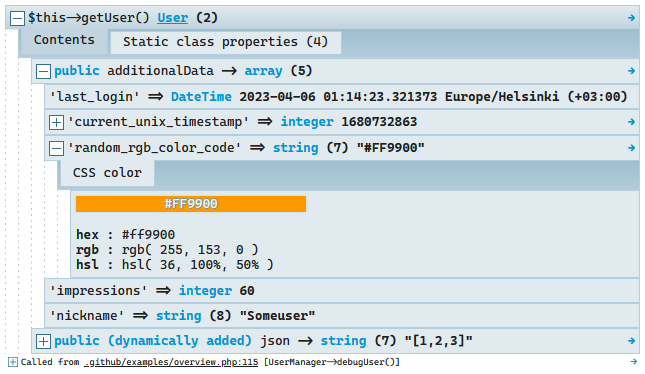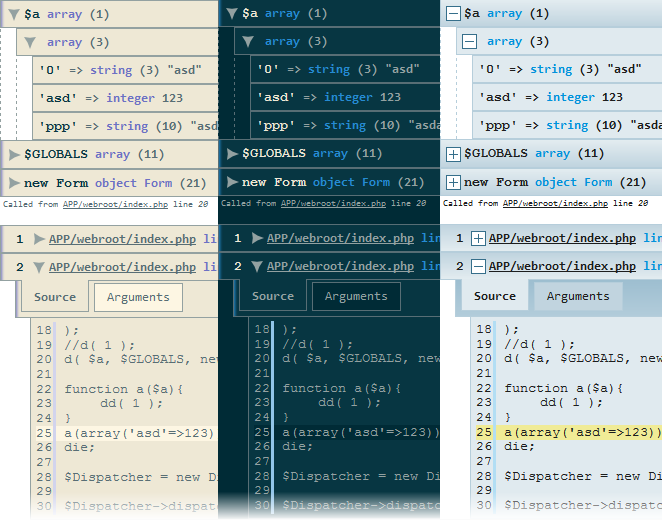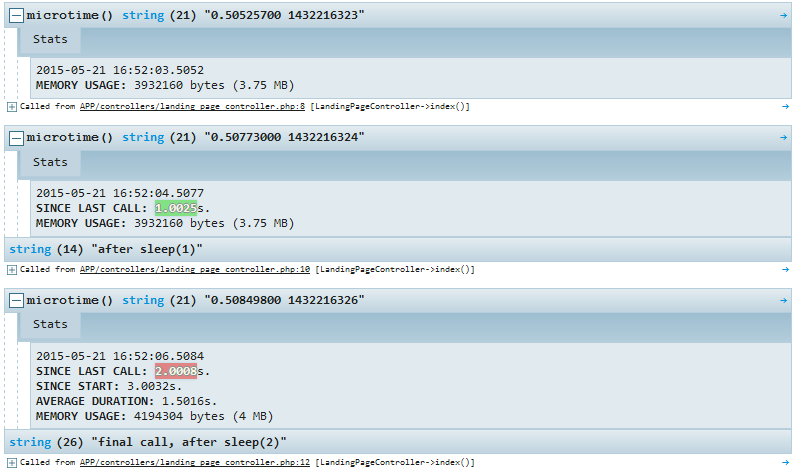raveren / kint
☯ Insightful PHP debugging assistant.
Installs: 1 553 924
Dependents: 94
Suggesters: 8
Security: 0
Stars: 2
Watchers: 1
Forks: 0
pkg:composer/raveren/kint
Requires
- php: >=5.1.0
Requires (Dev)
- seld/phar-utils: ^1.2
- symfony/finder: ^3.0 || ^4.0 || ^5.0
README
At first glance Sage is just a pretty replacement for var_dump() and debug_backtrace().
However, it's much, much more.
For an overview of Sage's outstanding features jump to the F.A.Q.
Installation
Download the phar and simply
<?php require 'sage.phar'; sage('Hello, 🌎!');
Or, if your project uses composer
composer require php-sage/sage --dev
Usage
sage($GLOBALS, $_SERVER); // dump any number of parameters saged($GLOBALS, $_SERVER); // alias for sage();die; sage(1); // shortcut for dumping trace
Customization options
Sage is designed with the utmost care to be as usable and useful out of the box, however there are several customization options available for advanced users.
Where to store customization?
If you use the phar version it does not get simpler:
require 'sage.phar'; Sage::$theme = Sage::THEME_LIGHT;
If using composer you have several options:
-
Create a separate PHP config file and ask composer to autoload it for you:
Add this entry to the
autoload.filesconfiguration key incomposer.json:
"autoload": { /* ... */ "files": [ "config/sage.php" /* <--------------- this line */ ] },
- Put settings inside of
php.ini:
; change sage theme: sage.theme = solarized-dark ; always display all dump levels, almost always crashes the browser: sage.maxLevels = 0 ; it's been 10 years, and phpstorm:// is still not working, Jetbrains, PLEASE! sage.editor = phpstorm-remotecall ; disable Sage unless explicitly enabled sage.enabled = 0
- Include the desired settings in your bootstrap process anywhere™.
List of available customization options
Sage::$theme = Sage::THEME_ORIGINAL;
Currently available themes are:
Sage::THEME_ORIGINALSage::THEME_LIGHTSage::THEME_SOLARIZEDSage::THEME_SOLARIZED_DARK
Sage::$editor = ini_get('xdebug.file_link_format');
Make visible source file paths clickable to open your editor. Available options are:
'sublime''textmate''emacs''macvim''phpstorm''phpstorm-remotecall'- this is the one I have been using for the past 8 years. Requires Remote call plugin.'idea''vscode''vscode-insiders''vscode-remote''vscode-insiders-remote''vscodium''atom''nova''netbeans''xdebug'
Or pass a custom string where %f should be replaced with full file path, %l with line number to create a custom link. Set to null to disable linking.
Sage::$displayCalledFrom = true;
Whether to display where Sage was called from
Sage::$maxLevels = 7;
Max array/object levels to go deep, set to zero/false to disable
Sage::$appRootDirs = [ $_SERVER['DOCUMENT_ROOT'] => 'ROOT' ];
Directories of your application that will be displayed instead of the full path. Keys are paths, values are replacement strings.
Use this if you need to hide the access path from output.
// Example (for Kohana framework (R.I.P.)): Sage::appRootDirs = [ SYSPATH => 'SYSPATH', MODPATH => 'MODPATH', DOCROOT => 'DOCROOT', ];
Sage::$expandedByDefault = false;
Draw rich output already expanded without having to click
Sage::$cliDetection = true;
Enable detection when running in command line and adjust output format accordingly.
Sage::$cliColors = true;
In addition to above setting, enable detection when Sage is run in UNIX command line. Attempts to add coloring, but if opened as plain text, the color information is visible as gibberish.
Sage::$charEncodings = [ 'UTF-8', 'Windows-1252', # Western; includes iso-8859-1, replace this with windows-1251 if you have Russian code 'euc-jp', # Japanese ]
Possible alternative char encodings in order of probability.
Sage::$returnOutput = false;
Sage returns output instead of printing it.
Sage::$aliases;
Add new custom Sage wrapper names. Optional, but needed for backtraces, variable name detection and modifiers to work properly. Accepts array or comma separated string. Use notation Class::method for methods.
// example, returns text-only output function MY_dump($args) { Sage::enabled(Sage::MODE_TEXT_ONLY); Sage::$returnOutput = true; // this configuration will persist for ALL subsequent dumps BTW! return d(...func_get_args()); } Sage::$aliases[] = 'my_dump'; // let Sage know about it. In lowercase please.
🧙 Tips & Tricks
// we already saw: sage($GLOBALS, $_SERVER); // you can also go shorter for the same result: d($GLOBALS, $_SERVER); // or you can go the verbose way, it's all equivalent: Sage::dump($GLOBALS, $_SERVER); // s() will display a more basic, javascript-free display (but with colors) s($GLOBALS, $_SERVER); // prepending a tilde will make the output even more basic (rich->basic and basic->plain text) ~d($GLOBALS, $_SERVER); // more on modifiers below // show a trace Sage::trace(); d(1); // shorthand works too! Sage::dump( debug_backtrace() ); // you can even pass a custom result from debug_trace and it will be recognized // dump and die debugging dd($GLOBALS, $_SERVER); // dd() might be taken by your framework ddd($GLOBALS, $_SERVER); // so here are some equivalent altenratives saged($GLOBALS, $_SERVER); sd($GLOBALS, $_SERVER); // available for plain display too! // this will disable Sage completely Sage::enabled(false); ddd('Get off my lawn!'); // no effect
-
Sage supports keyboard shortcuts! Just press d when viewing output and the rest is self-explanatory (p.s. vim-style
hjklworks as well); -
Call
Sage::enabled(Sage::MODE_PLAIN);to switch to a simpler, js-free output. -
Call
Sage::enabled(Sage::MODE_TEXT_ONLY);for pure-plain text output which you can save or pass around by first settingSage::$returnOutput = true; -
Sage can provide a plain-text version of its output and does so automatically when invoked via PHP running in command line mode.
-
Double clicking the
[+]sign in the output will expand/collapse ALL nodes; triple clicking a big block of text will select it all. -
Clicking the tiny arrow on the right of the output will open it in a separate window where you can keep it for comparison.
-
Sage supports themes:
For customization instructions read the section below.
-
If a variable is an object, its classname can be clicked to open the class in your IDE.
-
There are a couple of real-time modifiers you can use:
~d($var)this call will output in plain text format.+d($var)will disregard depth level limits and output everything (careful, this can hang your browser on huge objects)!d($var)will show uncollapsed rich output.-d($var)will attempt toob_cleanthe previous output - useful when Sage is obscured by already present HTML.
Here's a little bit on how it works.
-
Sage also includes a naïve profiler you may find handy. It's for determining relatively which code blocks take longer than others:
Sage::dump( microtime() ); // just pass microtime() sleep( 1 ); Sage::dump( microtime(), 'after sleep(1)' ); sleep( 2 ); ddd( microtime(), 'final call, after sleep(2)' );
F.A.Q.
💬 How is it different or better than symfony/var-dumper?
- Visible Variable name
- Keyboard shortcuts. Type d and the rest is just self-explanatory.
- Debug backtraces with full insight of arguments, callee objects and more.

- Custom display for a lot of recognized types:

- Has text-only, plain and rich views, is trivial to configure, has several visual themes - actually created by a pro designer.
- A huge amount of small usability enhancements - like the (clickable) call trace in the footer of each output.
- Supports convenience modifiers, for example
@sage($var);will return instead of outputting,-sage($var);willob_cleanall output to be the only thing on page. - Supports PHP 5.1+! That's the lowest physically possible version to extend compatibility to. Next time you headbang on something incredibly legacy, remember Sage!
- Is way less complex - to read and contribute to.
🔀 How is it worse?
- Does not come pre-bundled with your cool framework (but it is zero-setup!)
- Although Sage predates var-dumper, and I'm pretty sure it "inspired" the widespread use of the wonderful shorthand
dd, I stepped down to let var-dumper use this name. To dump & die with Sage you canddd()orsaged() - There's no such feature as a dump server, at least until someone convinces me it's actually useful.
- It's not made by Symfony foundation nor does it have industry-grade backing & support. It's made buy just this one guy (and contributors) since pre-2012.
💬 How is var_dump - style debugging still relevant when we have Xdebug?
- In practice, Xdebug is quite often very difficult and time-consuming to install and configure.
- There's many usecases where dump&die is just faster to bring up.
- There is no way you can visualise a timeline of changed data with XDebug. For example, all values dumped from within a loop.
- And there's more subtle usecases, eg. if you stepped over something there's no way to go back, but with var-dumping the values of interest are still there in the output...
I use xdebug almost daily, by the way. Side by side with Sage.
💬 What are the other dumpers out there
💬 Why does Sage look so much like Kint?
Because it is Kint, and I am its author, however the project was blatantly stolen from me by a malicious contributor!
Instead of fighting DMCA windmills, I chose to fork and rename the last good version and continue under a new name!
Author
Rokas Šleinius (Raveren)
License
Licensed under the MIT License
Hope you'll love using Sage as much as I love creating it!




